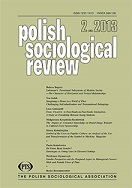Luhmann's Functional Subsystems of Modern Society - The Character of Horizontal and Vertical Relationships
Luhmann's Functional Subsystems of Modern Society - The Character of Horizontal and Vertical Relationships
Author(s): Bulcsu BognárSubject(s): Social Sciences
Published by: Polskie Towarzystwo Socjologiczne
Keywords: system theory; social theory; communication theory; social dynamic; organisational and social communication
Summary/Abstract: This study focuses on one of the basic questions of Luhmann's social theory relating to the description of modernity, namely, on the characteristics of subsystems and, even more specifically, it is aimed at gaining new recognitions concerning the relationships between subsystems. To do this, the study starts with sporadic comments in Luhmann's late work indicating historical and current inequalities between functional subsystems that are characterised in essence by a coordinating structure. Supplementing these recognitions by new arguments, the study concludes that besides the horizontal relationships, a variety of hierarchic (vertical) organisation forms also develop under the conditions ofmodernity. The dynamic of the subsystems is also affected by external irritations of unequal weights and frequencies of occurrence which, though not necessarily overwriting the autopoiesis of the various subsystems, definitely influences the importance of the various subsystems in the process of social communication. The other part of the study points out-by analysing the organisation's system level among other aspects-that vertical segmentation is a characteristic of the entirety of sociality besides the horizontal structure. Consequently, the study concludes that the description of modernity in Luhmann's social theory is in need of some adjustment.
Journal: Polish Sociological Review
- Issue Year: 182/2013
- Issue No: 2
- Page Range: 137-152
- Page Count: 15
- Language: English

